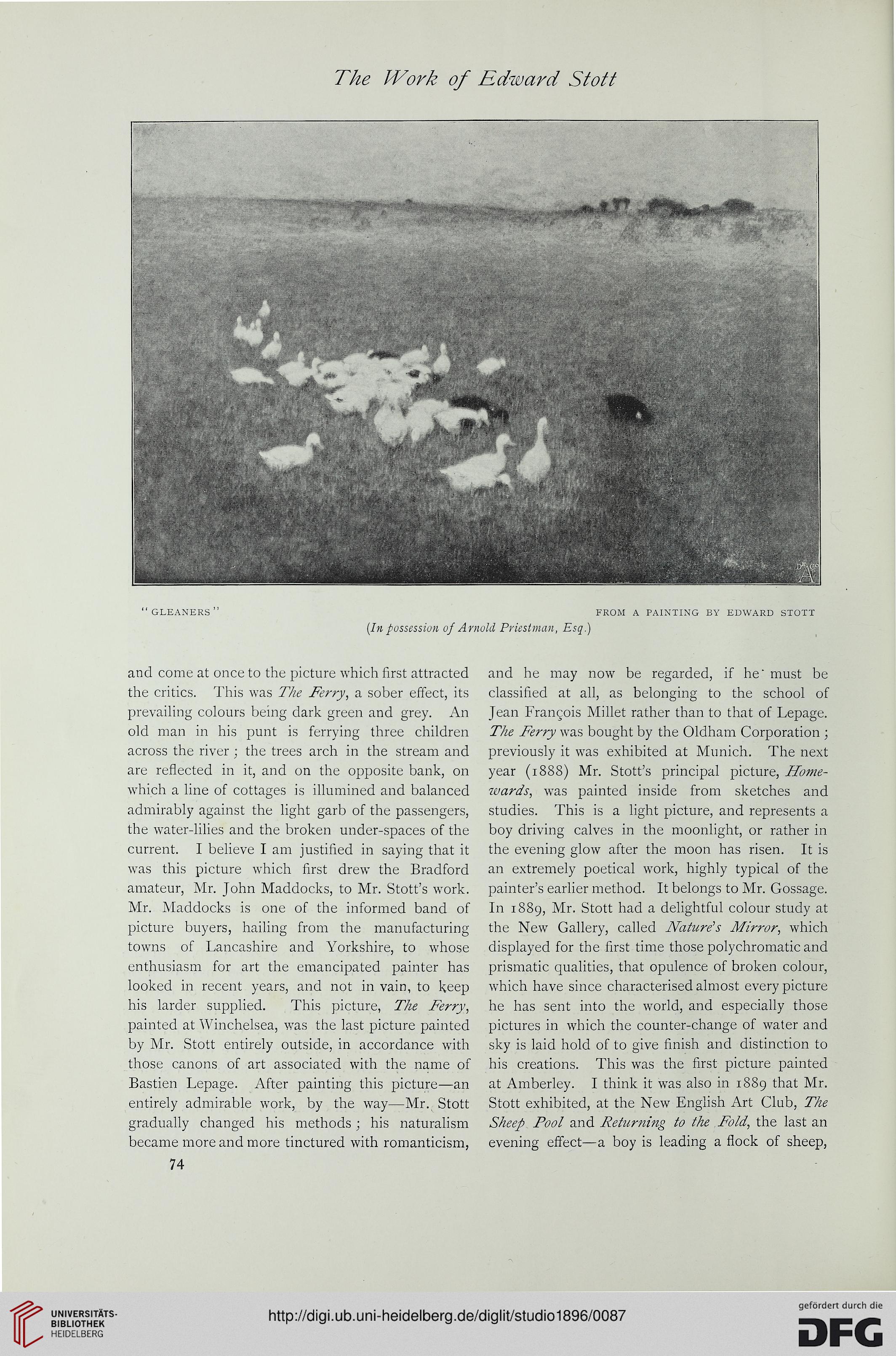The Work of Edward Stott
"GLEANERS FROM A PAINTING BY EDWARD STOTT
(In possession of Arnold Priestman, Esq.)
and come at once to the picture which first attracted
the critics. This was The Ferry, a sober effect, its
prevailing colours being dark green and grey. An
old man in his punt is ferrying three children
across the river ; the trees arch in the stream and
are reflected in it, and on the opposite bank, on
which a line of cottages is illumined and balanced
admirably against the light garb of the passengers,
the water-lilies and the broken under-spaces of the
current. I believe I am justified in saying that it
was this picture which first drew the Bradford
amateur, Mr. John Maddocks, to Mr. Stott's work.
Mr. Maddocks is one of the informed band of
picture buyers, hailing from the manufacturing
towns of Lancashire and Yorkshire, to whose
enthusiasm for art the emancipated painter has
looked in recent years, and not in vain, to keep
his larder supplied. This picture, The Ferry,
painted at Winchelsea, was the last picture painted
by Mr. Stott entirely outside, in accordance with
those canons of art associated with the name of
Bastien Lepage. After painting this picture—an
entirely admirable work, by the way—Mr. Stott
gradually changed his methods ; his naturalism
became more and more tinctured with romanticism,
74
and he may now be regarded, if he" must be
classified at all, as belonging to the school of
Jean Francois Millet rather than to that of Lepage.
The Ferry was bought by the Oldham Corporation ;
previously it was exhibited at Munich. The next
year (1888) Mr. Stott's principal picture, Home-
wards, was painted inside from sketches and
studies. This is a light picture, and represents a
boy driving calves in the moonlight, or rather in
the evening glow after the moon has risen. It is
an extremely poetical work, highly typical of the
painter's earlier method. It belongs to Mr. Gossage.
In 1889, Mr. Stott had a delightful colour study at
the New Gallery, called Nature's Mirror, which
displayed for the first time those polychromatic and
prismatic qualities, that opulence of broken colour,
which have since characterised almost every picture
he has sent into the world, and especially those
pictures in which the counter-change of water and
sky is laid hold of to give finish and distinction to
his creations. This was the first picture painted
at Amberley. I think it was also in 1889 that Mr.
Stott exhibited, at the New English Art Club, The
Sheep Pool and Returning to the Fold, the last an
evening effect—a boy is leading a flock of sheep,
"GLEANERS FROM A PAINTING BY EDWARD STOTT
(In possession of Arnold Priestman, Esq.)
and come at once to the picture which first attracted
the critics. This was The Ferry, a sober effect, its
prevailing colours being dark green and grey. An
old man in his punt is ferrying three children
across the river ; the trees arch in the stream and
are reflected in it, and on the opposite bank, on
which a line of cottages is illumined and balanced
admirably against the light garb of the passengers,
the water-lilies and the broken under-spaces of the
current. I believe I am justified in saying that it
was this picture which first drew the Bradford
amateur, Mr. John Maddocks, to Mr. Stott's work.
Mr. Maddocks is one of the informed band of
picture buyers, hailing from the manufacturing
towns of Lancashire and Yorkshire, to whose
enthusiasm for art the emancipated painter has
looked in recent years, and not in vain, to keep
his larder supplied. This picture, The Ferry,
painted at Winchelsea, was the last picture painted
by Mr. Stott entirely outside, in accordance with
those canons of art associated with the name of
Bastien Lepage. After painting this picture—an
entirely admirable work, by the way—Mr. Stott
gradually changed his methods ; his naturalism
became more and more tinctured with romanticism,
74
and he may now be regarded, if he" must be
classified at all, as belonging to the school of
Jean Francois Millet rather than to that of Lepage.
The Ferry was bought by the Oldham Corporation ;
previously it was exhibited at Munich. The next
year (1888) Mr. Stott's principal picture, Home-
wards, was painted inside from sketches and
studies. This is a light picture, and represents a
boy driving calves in the moonlight, or rather in
the evening glow after the moon has risen. It is
an extremely poetical work, highly typical of the
painter's earlier method. It belongs to Mr. Gossage.
In 1889, Mr. Stott had a delightful colour study at
the New Gallery, called Nature's Mirror, which
displayed for the first time those polychromatic and
prismatic qualities, that opulence of broken colour,
which have since characterised almost every picture
he has sent into the world, and especially those
pictures in which the counter-change of water and
sky is laid hold of to give finish and distinction to
his creations. This was the first picture painted
at Amberley. I think it was also in 1889 that Mr.
Stott exhibited, at the New English Art Club, The
Sheep Pool and Returning to the Fold, the last an
evening effect—a boy is leading a flock of sheep,




